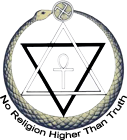"CascadIa"
Theosophy Magazine
Vol. 13, No.6, 1925
pages 258-261
There is sufficient evidence that the religious customs of the Mexicans, Peruvians, and other American races are nearly identical with those of the ancient Phoenicians, Babylonians, and Egyptians. (H. P. Blavatsky in Isis Unveiled, 1877.)
Identical glyphs, numbers, and esoteric symbols are found in Egypt, Peru, Mexico, Easter Island, India, Chaldea, and Central Asia. (H.P.B. in The Secret Doctrine, 1888.)
Now we find in the Zohar a very strange assertion,… It tells us that the serpent, which was used by Shamael …, to seduce Eve, was a kind of flying camel…. Cuvier, who has reconstructed their skeletons, is a witness to “flying camels.” … It is well known that Antiquity has never claimed palæontography and palæontology among its arts and sciences; and it never had its Cuviers. Yet on Babylonian tiles, and especially in old Chinese and Japanese drawings, in the oldest Pagodas and monuments, and in the Imperial library at Peking, many a traveler has seen and recognised perfect representations of Plesiosauri and Pterodactyls in the multiform Chinese dragons….
I. How could the ancient nations know anything of the extinct monsters of the carboniferous and Mesozoic times, and even represent and describe them orally and pictorially, unless they had either seen those monsters themselves or possessed descriptions of them in their traditions, which descriptions necessitate living and intelligent eye-witnesses?
II. And if such eye-witnesses are once admitted …, how can humanity and the first palæolithic men be no earlier than about the middle of the tertiary period? … most of the men of science will not allow man to have appeared before the Quaternary period, and thus shut him out completely from the Cenozoic times…. Evidently either the Mesozoic time has to be made to overlap the Quaternary period, or man must be made the contemporary of the Pterodactyl and the Plesiosaurus. … Pterodactyls and Plesiosauri ceased to exist with the bulk of the Third Race. (S.D. II, 205-206.)
…at least one great man of science, de Quatrefages, sees no good scientific reasons why man should not have been “contemporaneous with the earliest mammalia and go back as far as the Secondary Period.” (S.D. II, 219.)
…how much more logical to believe — as the Occultists do — that … many humanities, differing from our present mankind, … appeared but to disappear from the face of the earth, as our own will. Those primitive and far-distant humanities, having, as geologists think, left no tangible relics of themselves, are denied. All trace of them is swept away, and therefore they have never existed. Yet their relics — a very few of them, truly — are to be found, and they have to be discovered by geological research. (S.D. I, 609.)
CERTAIN centers — geographical, cultural, biological, or all three — for some reason become islands amid the roaring seas of universal change.
Through millions of years a little spot on the Nevada-California boundary — referred to as a part of lost Atlantis in The Secret Doctrine — has survived its many cataclysms as a sort of permanent continental nucleus, finally to arrive at upsetting modern scientific complacency and destroying laboriously constructed theories. The discovery of “Cascadia,” as it has been called, also illuminates as by a lightning flash H.P.B.’s enigmatic reference to “ruins strewn along and beyond the Rocky Mountains.”
Text-books still teach that man “descended from ape-like ancestors somewhere in Central Asia.” But this theory, held with touching faith, has become a mere credo resultant upon fixed habits of thought rather than upon concrete evidence at hand. Moreover, after the discoveries of the last three or four years, in Mexico and Central America in general, it has degenerated still further into a mere “Credo quia absurdum est.”
Allan le Baron’s discoveries in “Cascadia” have suddenly cut the Gordian knot by providing a new center of racial origin, which, according to the evidence at hand, antedates by far anything so far discovered in Europe; even to a greater extent than the Cuicuilco civilization. Space lacks for a full description of these discoveries, which will be found in the San Francisco Examiner during the summer of 1924; and more may be heard from them, as the Examiner is pushing the investigation.
Professor Keene, of the University of London, had asserted already that some of the Mexican remains date back 500,000 years; but le Baron’s finds go back still further.
In “Cascadia” were found pictographs identical in form with Egyptian, Chaldean, Babylonian, Chinese, and Arabian symbols; some of them very plainly, to the Theosophic eye, among the first cosmic symbols of the Wisdom-Religion from which all minor faiths branched and which in its purity survives today as Theosophy.
Four features of this sign writing indicate its formidable age:
1. It is primitive and unpolished in character; the same signs elsewhere, known to be at least 7,000 years old (in our opinion more like 70,000), are effete and decadent in comparison. Therefore these signs are looked upon by the discoverers as the origin of those used elsewhere.
2. There is no known tradition of migrations or crossings explaining the connection between these and the Asian signs, other than the echoes of forgotten Atlantis.
3. There are pictures of dinosaurs and extinct forms of animal life, though perhaps not as unmistakable as those found by the Hubbard Expedition in Grand Canyon, or by W. L. Chalmers at Grand Lake in the Colorado Rockies.
4. There is “desert varnish” and evidence of subsequent volcanic action over the inscriptions. The Examiner rhetorically asks that Geology explain what age this indicates. But Geology will not dare to do so — as yet.
For a long time the connection between man and the great reptiles will be a stumbling block, since according to accepted theories, dinosaurs were extinct some 10,000,000 years before the mammalian age; though, as it happens, a discovery was made by the last Hubbard expedition — of which Prof. Charles W. Gilmore, of the U.S. National Museum, was a member — which will ultimately upset all present theories on the subject.
Even the scientific mind yields before sufficient evidence; the old location of the origin of man has had its death-warrant written for some years, and the signature is now affixed. Thus a new theory, and wider outlook, begins to rise, and men of science are coming to think that:
1. America and not Asia is the “Garden of Eden”;
2. Mankind is immensely older than has been supposed; the ancient civilizations of Asia were full-blown and in some cases decadent at the dawn of “history.” Therefore their origins have to be found elsewhere, and the age of mankind is pushed back, according to some, 2,000,000 or more years.
3. There was an occupied Lemuria or Atlantis, somewhat confused at present.
This change of thought is strictly in the direction of the truth as taught by Theosophy. However, from the very manner in which it was arrived at, all its lines are jumbled, and the picture presented is a phantasmagoria rather than a panorama.
The true synthesis can come only from Theosophy, which is history, not deduced theories. By that history alone can a satisfactory development of the races be uncovered.
Both scientific theories are partly right; both are very incomplete. Lemuria, filling the Pacific, did exist, and the first civilized cities were built on that portion of its soil now known as Madagascar. Atlantis, whose greatest center was in the Atlantic, was fact, and in it lay the origin of all our institutions, as well as of our troubles, of today. Both of these, and then Central Asia in turn, became centers for the radiation of a new and transformed racial stock over-running the world.
The remains of these migrations and transformations are underfoot everywhere. Seen through a glass darkly by modern science, they present a troublous history without unifying continuity; and the “straight-line” theory of history, favored over the cyclic, presents an almost impassable barrier to understanding.
The realization of ignorance is the beginning of true wisdom. Could science divest its mind of theory and conceit, and, kneeling before the ancient altars of history and philosophy, begin in a reverent and humble spirit to pick up the lost threads anew, more progress would be made in a year than has been made in a century.
But, for this, that pride which leads men to prefer their own mistakes to the wisdom of others must be left behind; the “ape-ancestor” theory, so flattering to modern man, and so benumbing to the sense of responsibility, must be returned to limbo whence it came. For that theory must be substituted the vision of a race mental and spiritual in its original nature, becoming incarnate pari passu with the crystallization of matter from its substratum under the influence of primeval, impersonal cosmic intelligence. It must be understood that the Ashvatta Tree grows with its branches downward, and that the origin of mind is not to be sought in matter; on the contrary, the origin of matter rests with the mental basis of objective cognition — Mulaprakriti.
Back to Ancient Man

